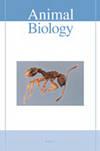欧亚两种树雀在不同海拔地区的生活史差异
IF 0.9
4区 生物学
Q2 ZOOLOGY
引用次数: 2
摘要
高度梯度造成的环境变化可以强烈地影响鸟类的生活史策略。为了充分理解这个问题,需要对同一物种在大海拔差异上的种群进行人口统计学比较。本文研究了两个欧亚树雀(Passer montanus)种群的繁殖生态,一个种群分布在海拔30 m的中国中部温带地区,另一个种群分布在海拔3430 m的青藏高原东北部高寒地区。在如此高的海拔地区,对该物种的繁殖生态研究很少。我们的研究结果显示,与低海拔地区的树麻雀相比,高海拔地区的树麻雀开始繁殖的时间较晚,繁殖期较短(80天对140天),产卵量较小(1.2只对2.5只),产卵量明显较小(4.0只对4.9只),但产卵量较大(4272对3443平方毫米)。此外,高海拔地点的树麻雀的筑巢期(14.5 d)比低海拔地点的长(13.4 d)。高海拔树麻雀的繁殖力往往较低,但它们会为每一个后代分配更多的能量,以应对高海拔地区的压力。观察到的模式与适应性生活史策略一致。本文章由计算机程序翻译,如有差异,请以英文原文为准。
Life history variation between two Eurasian tree sparrow Passer montanus populations at different altitudes
Altitudinal gradients create environmental variation that can strongly affect avian life history strategies. To fully understand this issue, a comparison of the demography of populations of the same species over large altitudinal differences is required. Here, we investigated the breeding ecology of two populations of Eurasian tree sparrow (Passer montanus), one in the temperate zone of central China at an altitude of 30 m and another in the alpine zone of the northeastern Tibetan plateau at an altitude of 3430 m. The breeding ecology of this species was rarely studied at such a high altitude before. Our result revealed that high-altitude tree sparrows started breeding later, had a shorter breeding period (80 versus 140 days), produced smaller broods (1.2 versus 2.5 chicks) and had significantly smaller clutches (4.0 versus 4.9 eggs) but larger eggs (4272 versus 3443 mm3) when compared with their low-altitude counterparts. Besides, tree sparrows at our high-altitude site had longer nestling periods (14.5 versus 13.4 days) than those at the low-altitude site. High-altitude tree sparrows tend to have reduced fecundity but allocate more energy into each offspring to confront the stressful conditions at high altitudes. The observed patterns are consistent with adaptive life history strategies.
求助全文
通过发布文献求助,成功后即可免费获取论文全文。
去求助
来源期刊

Animal Biology
生物-动物学
CiteScore
2.10
自引率
0.00%
发文量
34
审稿时长
3 months
期刊介绍:
Animal Biology publishes high quality papers and focuses on integration of the various disciplines within the broad field of zoology. These disciplines include behaviour, developmental biology, ecology, endocrinology, evolutionary biology, genomics, morphology, neurobiology, physiology, systematics and theoretical biology. Purely descriptive papers will not be considered for publication.
Animal Biology is the official journal of the Royal Dutch Zoological Society since its foundation in 1872. The journal was initially called Archives Néerlandaises de Zoologie, which was changed in 1952 to Netherlands Journal of Zoology, the current name was established in 2003.
 求助内容:
求助内容: 应助结果提醒方式:
应助结果提醒方式:


